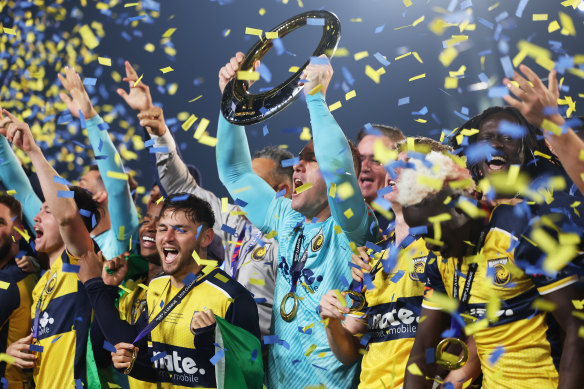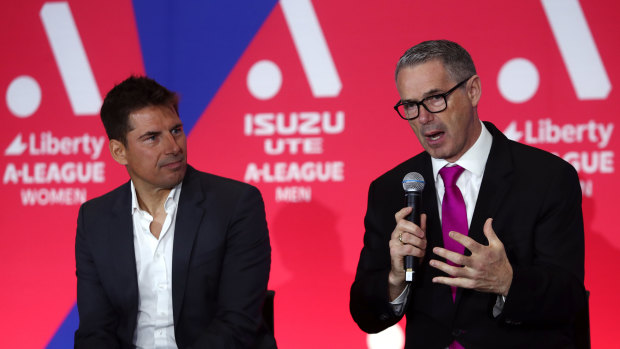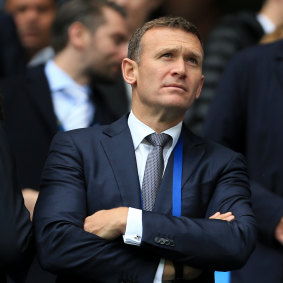This was published 8 months ago
‘Spent too much money’: A-League club distributions slashed to $500,000
By Vince Rugari
Australian Professional Leagues chairman Stephen Conroy has admitted the A-Leagues had no choice but to abandon its “overly ambitious” strategy and slash costs to stay afloat in a decision that has left clubs scrambling to address a dramatic financial shortfall and the professional game facing a period of austerity.
Club distributions for the 2024-25 season have been reduced to just $530,000, the APL confirmed on Wednesday, meaning club owners will have to find an extra $2.2 million just to cover the salary cap in the men’s and women’s leagues.

The Mariners celebrate their A-League Men grand final win earlier this year.Credit: Getty
It is a cut of almost $1.5 million from last season, and $3 million from the high of about six years ago when the competitions were administered by Football Australia and broadcast on Fox Sports.
The high point was just as the clubs began to agitate for an “unbundling” from the federation, made official on December 31, 2020, on the basis that it would vastly improve their financial prospects.
Instead, Conroy suggested the A-Leagues would have collapsed had they not moved away from their high-spending digital strategy, having shuttered the KEEPUP app and website in March and made more than half of the APL’s workforce redundant.
He all but confirmed the $140 million private equity investment from Silver Lake had been spent and that penalty clauses within the APL’s broadcast rights deal with Paramount – as first reported by this masthead – had meant it was not worth as much as was publicly announced when the deal was inked in May 2021, thus necessitating immediate budgetary adjustments.

A-Leagues commissioner Nick Garcia (left) and chairman Stephen Conroy.Credit: Getty
Conroy and APL commissioner Nick Garcia, who spoke to reporters on Wednesday afternoon, said there was no imminent risk of any of the 13 clubs folding as a result of the measures from the feedback they had received, but warned that the A-Leagues would be facing a difficult 12 to 18 months until the next broadcast deal hopefully improves their fortunes.
“Launching into COVID was not the moment to go for a big, bold, ambitious strategy,” said Conroy, the former Labor senator who was appointed APL chairman in September.
“There was a lot of ambition behind the KEEPUP strategy. Obviously, it’s a strategy we’ve largely retired ... you wouldn’t do that again if you’re about to launch into COVID. There’s been a string of, I’d say, optimistic projects that were embarked on which didn’t pay off, and so the decisions we took over the last six to nine months have been to focus on football strategy.

Simon Pearce.Credit: Getty Images
“I describe it as being overly ambitious at the wrong moment, and the consequences for the league are that we’re having to significantly cut our cloth. The league ran too fast, spent too much money. The Silver Lake investment has been widely reported to have been spent, and so the ability to dip into a sort of capital reserve to fund recurrent losses just didn’t exist.
“We’re reviewing every single cost inside the business to make savings so that we can reduce the impact ultimately on the distributions, but the distributions were the single largest cost. And they were based on a set of numbers in the TV deal ... the numbers, as has been widely reported, reduced, and therefore a gap opened up. We have to do everything we can to ensure that we have a sustainable APL.”
While the APL is now projecting to break even in the next financial year, club owners will have to wear a collective hit of almost $20 million a season until the next broadcast deal, which will take effect from the 2026-27 competition.
“While clubs are obviously hurting by the size of this reduction, no one gave any indication they [would collapse],” Conroy said. “They obviously weren’t dancing a jig, but no one said, ‘Right, that’s it, we are shutting the doors’.”
Almost all of the APL’s previous leadership, who were the drivers behind their split from FA and the KEEPUP strategy, have departed or have heavily diminished roles within the sport. Former APL chairman Paul Lederer left the board in December 2023 and is also no longer chairman of Western Sydney Wanderers, Anthony Di Pietro left the board in December 2022 amid the furore over the scrapped grand final deal with Destination NSW, Scott Barlow left the board last month, while former chief executive Danny Townsend departed in October and is now working in Saudi Arabia.
Simon Pearce, the Melbourne City vice-chairman and City Football Group powerbroker who is regularly described as one of the most influential figures in the Australian game, remains on the APL board.
Asked directly if Pearce would continue in that role, Conroy said. “We’ve all already seen a couple of directors stand down. It won’t surprise me if a couple more stand down. As to individuals you want to name ... the board is elected by the club owners, unit-holders as they’re called. But I think you’ll see a significantly different board after the elections, which are in September.”
Sources familiar with the APL’s predicament, who were not authorised to speak publicly, said an even lower distribution figure – or even no money at all – would have been on the cards were it not for renegotiations with broadcast partner Paramount, Football Australia and other parties, which have helped manage costs. The sources also suggested that the APL had, in fact, been effectively overpaying clubs for several years based on what it could afford.
Clubs have been aware for months that distributions would be dramatically decreased, Conroy said. While the situation is likely to lead to an exodus of highly paid players and a struggle to attract credentialed foreigners, Conroy pointed to the recent success of the Central Coast Mariners – who won the treble with the lowest budget in the A-League Men – as proof that it would not necessarily impact the on-field product.
There is a reasonable expectation that the APL’s next broadcast deal – with negotiations to begin in the next six-to-nine months – will be a material increase on the current deal, given the A-Leagues have had three successive years of growth in attendances and increases in television viewership and memberships. However, Paramount is also facing an uncertain future globally, and their Australian subsidiary – which owns and operates Network Ten – has also undergone recent cost-cutting exercises.
Conroy also ruled out any possibility of the APL seeking to merge again with Football Australia, as has been rumoured, but said both organisations were in discussions about the possibility of shared services to further cut costs.
“In terms of the level of potential co-operation with the FA, that’s probably the brightest spot in terms of the discussions that we’ve been having,” he said.
“They want the A-League to be successful because they understand that a strong A-League means a strong pipeline for the Matildas and the Socceroos. As soon as we can reunite the pyramid in a raft of really constructive ways, the better, and that’s what both boards are working on at the moment.”
As for Silver Lake, Conroy said the investment firm was “leaning in rather than being critical” and did not rule out the prospect of the APL exploring another capital raise.
Sports news, results and expert commentary. Sign up for our Sport newsletter.